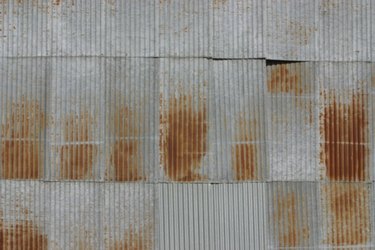Things You'll Need
Drill
Claw hammer
Pry bar

Metal roofing is installed in overlapping sheets. The edges are typically held down with trim pieces that are fastened to the edges of the roof beforehand. The panels and trim are held in place by self-tapping sheet metal screws, installed with a drill driver. To remove a metal roof, simply reverse engineer the installation process.
Step 1
Start your removal along the top edge in the corner last installed. Examine the edges of the roof panels to locate the last panel, which will be attached with screws through its face, rather than hidden by an overlapping piece, or attached via hidden clips. Remove the screws along the long edge of this sheet.
Video of the Day
Step 2
Move to the opposite edge of the sheet, lifting it up as you go. Look for screws through the face of the material, if the roof is corrugated, or other basic metal. Look for hidden clips if the roof is standing seam. Use a claw hammer to pry underneath the edge to pop the metal loose from hidden clips. Remove any visible screws with a drill or impact driver.
Step 3
Use a pry bar as needed along the bottom edge of the sheet to pry the metal loose from any sealing tape placed in the joint. Continue across the roof, removing each panel as you come to it, across the width of the roof. Start at one end of the second row of metal panels and remove them using a similar method. Drop loose sheets to the ground to prevent them being caught by wind.
Step 4
Remove all of the metal sheeting. Undo screws from hidden clips to remove them, if they did not pull loose with the panels. Remove the screws in the edges of the ridge, side and bottom edge trim surrounding the roof using the drill. Typically the trim on the sides of the roof will be screwed down along one edge, as will the trim at the bottom edge of the roof. Ridge trim will be fastened along both edges. Remove the sheets from the top row of the opposite face of the roof before removing ridge trim.
Video of the Day